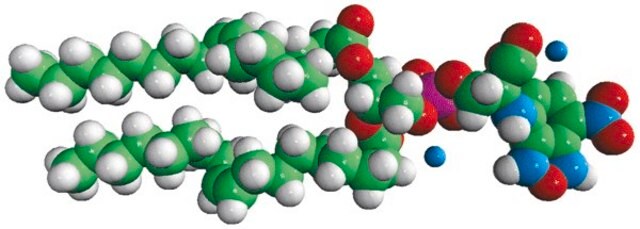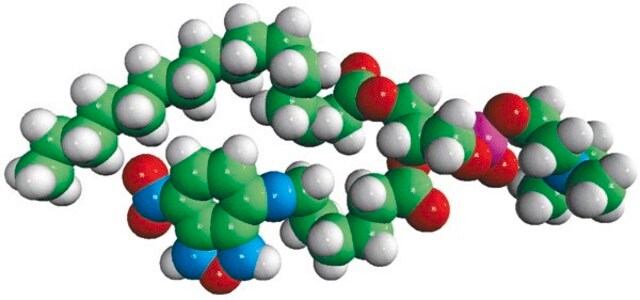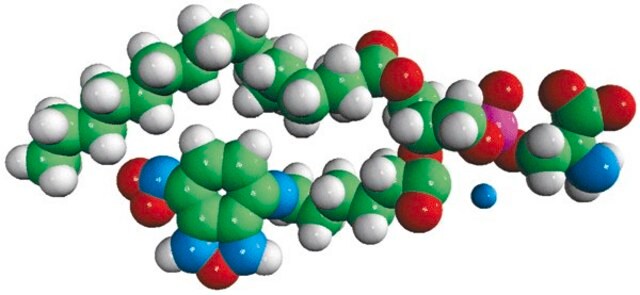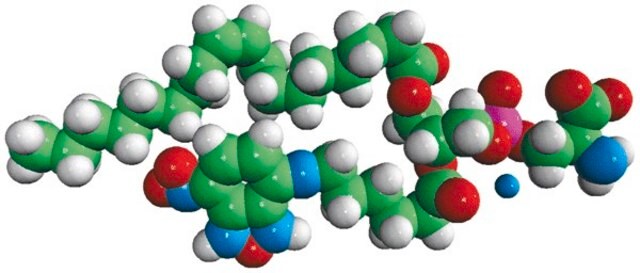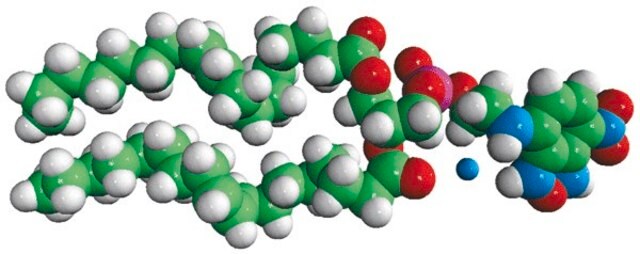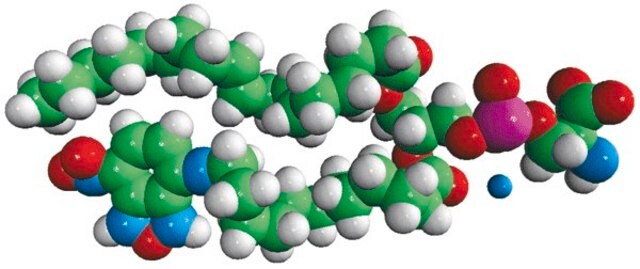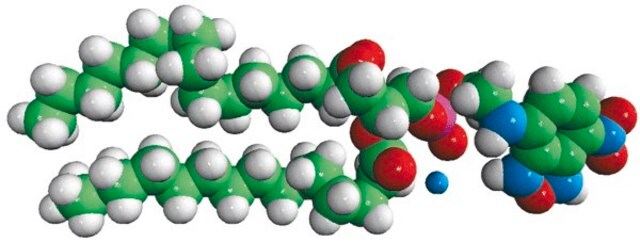810192P
Avanti
16:0-06:0 NBD PS
Avanti Research™ - A Croda Brand 810192P, powder
Synonym(e):
1-palmitoyl-2-{6-[(7-nitro-2-1,3-benzoxadiazol-4-yl)amino]hexanoyl}-sn-glycero-3-phosphoserine (ammonium salt)
Anmeldenzur Ansicht organisationsspezifischer und vertraglich vereinbarter Preise
Alle Fotos(2)
About This Item
Empirische Formel (Hill-System):
C34H59N6O13P
CAS-Nummer:
Molekulargewicht:
790.84
MDL-Nummer:
UNSPSC-Code:
12352211
NACRES:
NA.25
Empfohlene Produkte
Assay
>99% (TLC)
Form
powder
Verpackung
pkg of 1 × 1 mg (810192P-1mg)
Hersteller/Markenname
Avanti Research™ - A Croda Brand 810192P
Versandbedingung
dry ice
Lagertemp.
−20°C
Allgemeine Beschreibung
Phosphatidylserine (PS) is a membrane phospholipid enriched in the cytosolic leaflet of plasma membrane. It comprises 2-10% of total phospholipids. NBD PS is a flurosently labelled phospholipid with 7-nitrobenz-2-oxa-1,3-diazol-4-yl (NBD) at the headgroup of PS.
Anwendung
16:0-06:0 NBD PS has been used as a labelled translocase to detect ATP-dependent translocation across late Golgi membranes. It is also suitable for analysis of phospholipid scramblase 1 (PLSCR1) scrambling in proteoliposomes and to determine enzyme specificity of lipoteichoic acid synthase enzyme (LtaS).
16:0-06:0 NBD PS or 1-palmitoyl-2-{6-[(7-nitro-2-1,3-benzoxadiazol-4-yl)amino]hexanoyl}-sn-glycero-3-phosphoserine (ammonium salt) has been used in the 7-nitrobenz-2-oxa-1,3-diazol-4-yl (NBD) − phospholipase (PL) translocation assay to characterize an ATP-dependent flippase activity in yeast Golgi membranes. It may be used: to detect vesicular stomatitis virus G (VSV G) protein mediated cell-cell fusion, measure the enzyme substrate specificity of lipoteichoic acid (LTA) synthase (LtaS), in liposomes to determine the role of phospholipid scramblase 1 (PLSCR1) in phospholipid scrambling.
Biochem./physiol. Wirkung
Phosphatidylserine (PS) is involved in the regulation of many enzymes and structural components. It serves as an essential factor in the clearance of apoptotic cells. It is associated with cognitive disability in Alzheimer′s disease.
Verpackung
5 mL Amber Glass Screw Cap Vial (810192P-1mg)
Rechtliche Hinweise
Avanti Research is a trademark of Avanti Polar Lipids, LLC
Lagerklassenschlüssel
11 - Combustible Solids
Hier finden Sie alle aktuellen Versionen:
Analysenzertifikate (COA)
Lot/Batch Number
Leider sind derzeit keine COAs für dieses Produkt online verfügbar.
Wenn Sie Hilfe benötigen, wenden Sie sich bitte an Kundensupport
Besitzen Sie dieses Produkt bereits?
In der Dokumentenbibliothek finden Sie die Dokumentation zu den Produkten, die Sie kürzlich erworben haben.
An Unrecognized Function of Cholesterol: Regulating the Mechanism Controlling Membrane Phospholipid Asymmetry
Arashiki N, et al.
Biochemistry, 55(25), 3504-3504 (2016)
Measuring translocation of fluorescent lipid derivatives across yeast Golgi membranes
Natarajan P, et al.
Methods, 39(2), 163-168 (2006)
Osmotic stress adaptation in Lactobacillus casei BL23 leads tostructural changes in the cell wall polymer lipoteichoic acid
Palomino MM, et al.
Microbiology, 159(11), 2416-2426 (2013)
Mirka E Wörmann et al.
Molecular microbiology, 79(3), 566-583 (2011-01-25)
Lipoteichoic acid (LTA) is an important cell wall polymer in Gram-positive bacteria. The enzyme responsible for polyglycerolphosphate LTA synthesis is LtaS, first described in Staphylococcus aureus. Four LtaS orthologues, LtaS(BS) , YfnI, YqgS and YvgJ, are present in Bacillus subtilis.
Maria Karatsa-Dodgson et al.
Journal of bacteriology, 192(20), 5341-5349 (2010-08-17)
Lipoteichoic acid (LTA) is an important cell wall component of Gram-positive bacteria. The key enzyme responsible for polyglycerolphosphate lipoteichoic acid synthesis in the Gram-positive pathogen Staphylococcus aureus is the membrane-embedded lipoteichoic acid synthase enzyme, LtaS. It is presumed that LtaS
Unser Team von Wissenschaftlern verfügt über Erfahrung in allen Forschungsbereichen einschließlich Life Science, Materialwissenschaften, chemischer Synthese, Chromatographie, Analytik und vielen mehr..
Setzen Sie sich mit dem technischen Dienst in Verbindung.